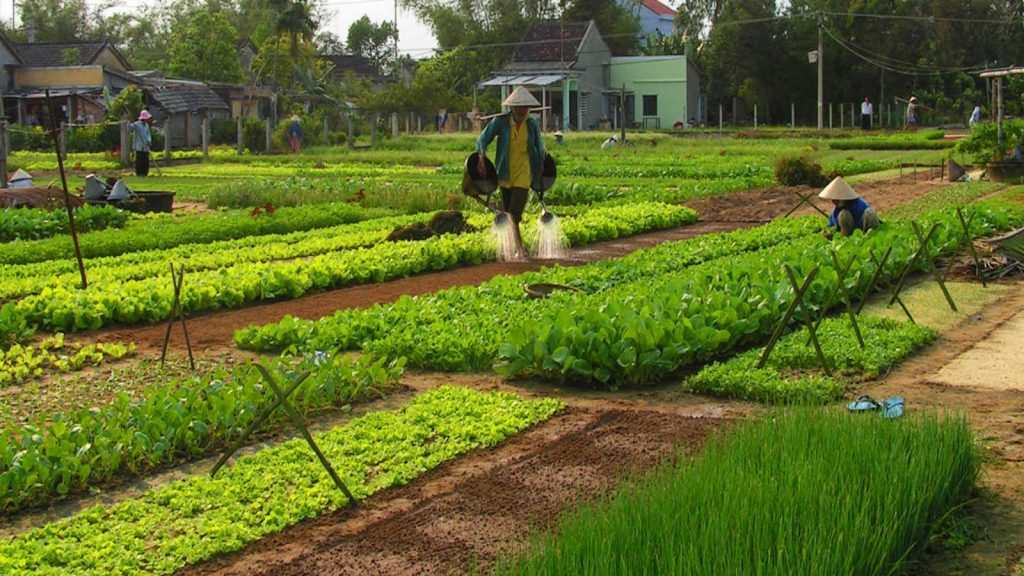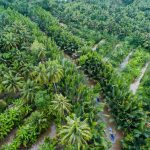In addition to naturally fertile land, humble algae and weeds living in the ponds near the De Vong River can rightly take some of the credit for Tra Que’s delicious fame and distinct flavors. The village, named after a sweet-flavored herb cultivated in this area, is located north east of Hoi An old town. Centuries ago, it was an important stopping point for boats sailing down the De Vong river from/to Da Nang. Due to the natural qualities of this area its fame as a leading vegetable production center quickly grew.
The years come and go, but the residents of Tra Que Hamlet, in Cam An Village, have diligently cultivated their land for generations using effective authentic methods, plus the application of a fascinating process.

For hundreds of years farming throughout Vietnam was traditionally organic based. The Tra Que farmers keep organic farming methods alive by uniquely using the algae and weeds instead of manure or chemical fertilizer. It is these organic organisms which are the intriguing secret behind the Tra Que Village vibrant healthy greens and fresh flavors.
The village cultivates more than 20 kinds of herbs and vegetables including basil, knotweed, Vietnamese mint, coriander, perilla (a herb of the mint family), lettuces, onions and so forth. The produce of Tra Que are important ingredients in traditional dishes, which uniquely define Hoi An’s cuisine. Many recipes, such as banh xeo (a type of savory crisp pancake), Cau Lau (the famous regional noodle soup), Mi Quang noodles and so forth, demand fresh vegetables and herbs. A combination of fresh vegetables releases the five flavors and stimulates the senses. One particular dish which importantly relies on the Tra Que ingredients is Tom Huu or tam huu. This literally means “prawns’ friends” or “three friends”. Prawns and pork are wrapped in water mint leaves grown in Tra Que and secured with thin strips of green onion. The way the ingredients are tied together, creating a “friendship of flavors”, inspired the name of this variety of Vietnamese fresh roll.
To both supplement their income and proudly demonstrate effective farming techniques, the villagers have firmly put Tra Que on the tourist map. Domestic and international visitors can participate in various agricultural activities, experience local farming life, witness farming procedures including raking, sowing, tilling the land, watering, picking the vegetables and herbs and so on. The farmers take time to explain the fertilizing methods and other aspects of farming. The combination of this traditionally idyllic rural setting plus a chance to roll up one’s sleeves and till the land makes Tra Qua such an attractive destination.

Being a farming community, the villagers pray for successful crops to sustain their livelihood. Playing an important role in the village for over 500 years is the Cau Bong Festival. Held on the 7th day of the 1st lunar month this colorful and lively ceremony calls for a good harvest. The villagers pray to the God of the Harvest and the founders of the village, asking for a bumper crop, good weather and prosperity during the coming year. Early morning the villagers prepare offerings of sticky pink rice (symbolizing luck and a good crop), chicken, incense, flowers and other votive offerings. The elders lead the procession in honor of the ancestors. Women in traditional ao dai carry the five fruits tray. Offerings are made at the temple, prayers are chanted and rituals followed. As well as the traditional formalities, it is also a time for fun activities and entertainment. There are food stalls, vegetable and herb displays and competitions, a boat race and the chance for festival goers and visitors to join the locals with some farming activities.
Nowadays, around 220 households still maintain this agricultural occupation. To illustrate the farming community’s size and productivity – Tra Que village covers an area of 18 hectares with a capacity of 300 quintals per hectare (one quintal relates to 100 kg). In value terms, a few years ago statistics indicated a total volume of 540 tons worth 9.2bn VND. Tra Que vegetables and herbs rightfully have a superb reputation for freshness, high quality, food safety and distinct flavors. As such, the village supplies most of the major restaurants in Hoi An, as well as a distribution network throughout Quang Nam province, Hue and down to Saigon.
We end with some food for thought. Maybe it would be more accurate to regard the villagers not as farmers but as artisans. Applying skillful farming techniques, handing down knowledge from generation to generation, combined with wonderful aromas and vibrant colors, Tra Que’s industry is more like an art form. And a particularly delicious one at that.
Tra Que Organic Vegetable village
Tra Que Hamlet, Cam An village
Northeast of Hoi An old town
La Siesta Resort & Spa arranges tours to Tra Que village. Visit the gardens, join the farmers in preparing and fertilizing the land. Attend one of Tra Que village cooking classes or visit the village on its annual festival day.
Please speak to our tour desk for more information.
Source: ehgnews.com






